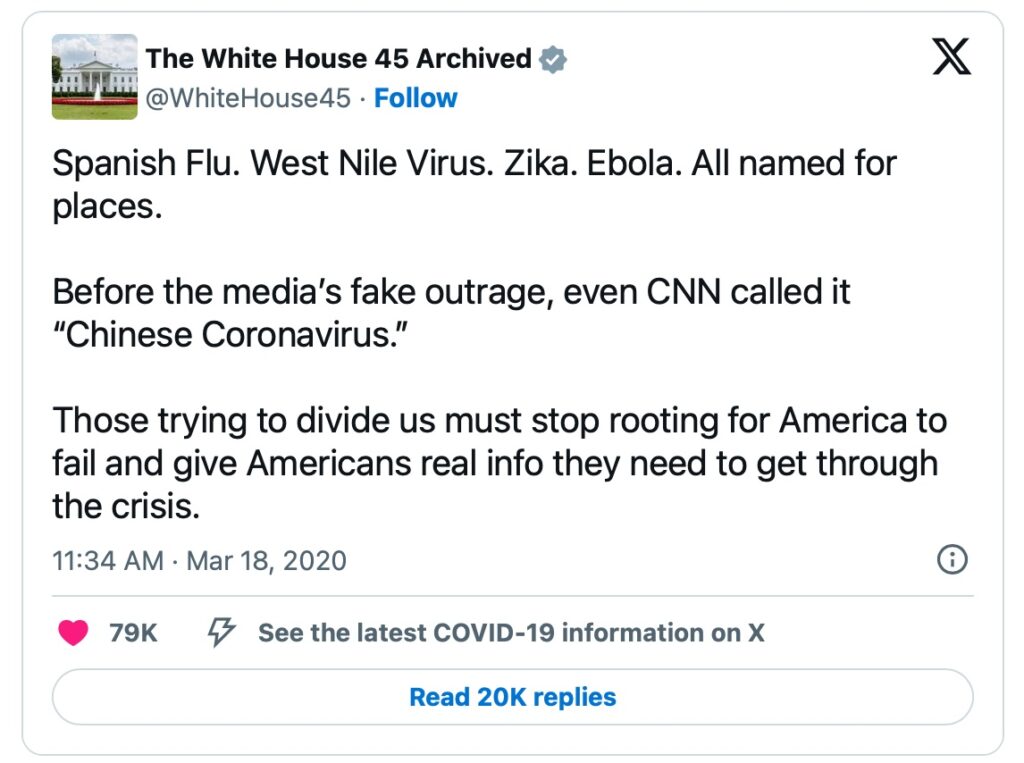By EMILY KOPP | DAILY CALLER NEWS FOUNDATION
The New York Times quietly edited its early articles on the Covid-19 pandemic to scrub the phrases “China virus” and “Wuhan virus,” only to hit President Donald Trump for using the same terms weeks later, according to a review of archived versions of several early pandemic stories.
“Whistle-Blower On China Virus Succumbs to It,” reads the headline of a Feb. 6, 2020, story describing the death of Li Wenliang, an ophthalmologist who raised the alarm about the spread of a SARS-like pneumonia with friends on social media and later died with Covi-19. By the next day, the headline on the outlet’s website read differently: “Chinese Doctor, Silenced After Warning of Outbreak, Dies From Coronavirus.”
The Times also deleted references to the “Wuhan virus” to describe the emerging novel coronavirus from stories in January and February 2020, according to archived versions available in LexisNexis reviewed by the Daily Caller News Foundation. None of the stories disclose the change through corrections or clarifications.
A Feb. 11, 2020 article about the virus’ spread in Indonesia originally stated that “Indonesia has three laboratories capable of testing for the Wuhan virus.” The article was quietly amended a day later to read, “Indonesia has three laboratories capable of testing for the new coronavirus.”

A spokesman for the New York Times said the paper “intensely pursued every theory and lead on the origins of Covid-19” in a statement to the DCNF.
“The New York Times has intensely pursued every theory and lead on the origins of Covid-19, documented the political debate, funding, influence, and shifts in thinking among the scientific community, and reported on China’s censorship campaign that has stifled the search for truth,” said New York Times External Communications Managing Director Charlie Stadtlander. “The Times has helped readers navigate the coronavirus pandemic through independent, verified reporting, and rejects any insinuation that we displayed bias in this process.”
The revelation comes amid Trump’s pushback against the legacy press for years of distorted coverage, including a lawsuit against the board of the Pulitzer Prizes for a 2022 statement that defended awarding the prestigious national reporting prize to the Times in 2018 for stories on “Russiagate.” The suit describes the media frenzy as “a debunked, self-authenticating scheme between partisan opposition research organizations, top levels of law enforcement and the media.”
The Pulitzer Board asserted in the 2022 statement that none of the reporting had been discredited despite contrary evidence.
The New York Times won four Pulitzer Prizes on Monday for its coverage of U.S. policy in Afghanistan, the conflict in Sudan, the Butler assassination attempt, and fentanyl overdoses in Baltimore, the board announced.
‘Fake Outrage’
A search of LexisNexis, an online database that compiles thousands of news sources, reveals other examples of the phrase “Wuhan virus” being deleted by the Times without a trace.
“Health officials say the Wuhan virus probably originated from [Chinese horseshoe bat] or a similar species,” reads the original caption of a photo in a Jan. 28, 2020, article.
By Jan. 29, 2020, the caption of the same photo in the same article did not mention the virus at all: “A Chinese horseshoe bat in flight. There are more than 1,200 species of bat, making up about a quarter of all mammalian species.”
By March 18, 2020, the Times alleged that President Donald Trump’s use of the terms “China virus” and “Wuhan virus” ignored “a growing chorus of criticism that it is racist and anti-Chinese” — without disclosing its own apparent editorial gaffes.
The Times’ editorial policy was not uniform. Some references to the “Chinese virus” and the “Wuhan virus” remain online.
A story dated Jan. 23, 2020, refers to “the Wuhan virus” in a discussion about the genetic similarities between the emerging novel coronavirus and a cousin virus at the Wuhan Institute of Virology. An op-ed the same day by Yanzhong Huang, a senior fellow for global health at the Council on Foreign Relations, also refers to “the Wuhan virus.”
A Jan. 27, 2020, story makes mention of the “Wuhan coronavirus”: “Some 110 patients in 26 states are being evaluated for infection with the Wuhan coronavirus.”
“The Chinese virus is spreading,” reads a Feb. 4, 2020, story from the business desk.
As the press corps peppered the president with questions about the term “China virus,” the White House’s official account hit back, pointing out even CNN used the term before it became a political flashpoint.
“Spanish Flu. West Nile Virus. Zika. Ebola. All named for places. Before the media’s fake outrage, even CNN called it “Chinese Coronavirus,” reads a March 18, 2020, tweet.

The China Daily, an English-language newspaper published by the Chinese Communist Party’s propaganda department, echoed the narrative found in the Times that the phrase “Wuhan virus” was stigmatizing.
“US Democrats have slammed Trump and other Republicans for using ‘Chinese’ or ‘Wuhan’ when referring to the virus in public statements and social media posts,” the paper stated on March 21, 2020.
Trump defended his use of the term “China virus” as important to push back on CCP propaganda claiming the virus originated with U.S. military officers. The CCP reiterated the argument on April 30 that “Covid-19 may have emerged in the US earlier than the US official timeline, and earlier than the outbreak in China,” which is not consistent with the epidemiology.
The issue gained salience again in the spring of 2021 in the wake of the World Health Organization-China mission to Wuhan to investigate the virus’ origins. The mission’s conclusions were swayed by Chinese authorities, according to mission chief Peter Ben Embarek. The report dismissed a lab origin as “extremely unlikely” while lending credence to the theory that the virus had been imported from outside of China through frozen food. Within hours, Director-General, Tedros Adhanom Ghebreyesus said that “all hypotheses remain on the table” and more studies were needed.
On May 20, 2021, the Chinese Americans Civil Rights Coalition, Inc. sued Trump for defamation over his use of the terms “Chinese virus,” “China virus,” “Wuhan virus,” and “Kung Flu virus.” Media outlets around the world reported on the complaint, including Axios and Der Spiegel. The coalition maintains no web presence.

I remember the day there was an announcement about the Wuhan flu. It laid out the guidelines…You will no longer make reference to China. It is now COVID 19 and you will call it as such. Mention China or question the CDC and you will be canceled. Don’t question Lord Fauci either.
Please be more specific. What story are you talking about?
You are correct Frank.
It is simply a story.
There is an old saying “if you havent heard any good rumors lately it is time to make one up of your own”.
The Pulitzer prize is meaningless, and has been for along time, to everyone but self-absorbed “journalists”. Some “reporter” at Anchorage Daily News got the prize many years ago for a completely fabricated series of articles.